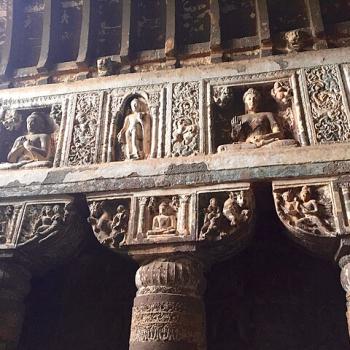A couple of things followed my previous posting, a small and very much preliminary reflection on the one and the empty in Zen realization. One turned on my allusion to an article by Victor Sogen Hori, “Teaching and Learning in the Rinzai Zen Monastery.” I’d not in fact read the article, but rather found a very useful pull quote from an essay in Wikipedia. Hori is magnificent, a first rate scholar as well as a long time Zen practitioner, Rinzai priest with a dozen years of Japanese monastic training under his belt. And the quote was exactly what I needed.
Then an old friend provided a link to the article. A friend who is a Zen teacher then said, James, read it! I did. My goodness it is wonderful.
It, along with ongoing blog posts first from No Zen in the West and Wild Fox Zen and more recently from Nyoho Zen, opens very serious questions about Zen training and Zen training in the West.
In brief, in both Soto and Rinzai, the container for Zen training is very tight. One enters the monastery and from that moment every single aspect of one’s life is controlled. And this means everything from brushing one’s teeth to going to the toilet. Even your bed is not your own. The Rinzai wrinkle appears to include virtually no instruction. Soto doesn’t provide much more. Rebuke becomes the major currency.
And it lasts. To become a temple priest people endure this structure for a period of time, three years seems a magic number, but many get away with less, sometimes a lot less. But folk who become teachers go on with this for years and years, ten, twenty.
There is a certain amount of formal study, engaging the sacred texts of the tradition. And in Rinzai there is the koan curriculum.
In this way one just does it. There’s your pillow. Sit down. Why is not a question. How is not explored in any detail. Doing is all.
People throw themselves into the project. Lots and lots of zazen. Lots and lots of rebuke for doing it wrong, without explaining what wrong is. Long days. Short nights. Work and meditation, and more rebukes. And somewhere along the line one understands.
At least that’s the theory.
And I’ve met a couple of people who have done their training this way who I think really have come to something worthy. And, I’ve met those who seem more broken to me, and not in that good way, who were twisted to the container without ever quite getting it.
Of course, best I can tell, nothing works for everyone.
And then there’s what we encounter here in the West.
I’m going to limit my remarks to the Japanese inheritance, although there should be some resonances for other traditions that have come west.
Mostly we find we have two things. Zazen. And, for some koans. And, for some, a time of fairly rigid monastic, or more properly, quasi-monastic training. A bit more, to my lights, like living under a Western monastic rule than the Japanese model. Tight, but not as tight.
Here in the West there are the sodo-like institutions that create monastic rule environments. With or without koans. (Actually pretty much all use koans, but for me “without” means without the introspection direct pointing with right and wrong responses associated with Hakuin style curriculum koan practice.)
And, I’ve witnessed some genuine movement of heart and mind within these institutions. Their dangers, as I see it, is that without a larger tradition and the relatively easy possibility of moving from one to another, sometimes the container becomes capriciousness. And, while some profit, I really think this kind of instruction is ultimately bad for everyone from student to teacher. It leads to cultishness and a confusion of cruelty for skillful means. Different training monasteries deal with these issues in different ways. The problem for pretty much all of them, I feel, is too often they don’t fully understand the difference between tight container and capriciousness. Some are better at this than others. But all seem marked by this difficulty. So, if true, and I think it is, a mixed bag.
Most people, however, who practice Zen, do not live in a controlled rule based environment beyond regular or occasional retreats. The average Zen practitioner today sits with a group that meets maybe once a week, perhaps a bit more regularly. And hits a retreat once in a while, maybe once or twice a year.
And this is not just the average practitioner, this is most practitioners.
And so a question.
Are they being served adequately?
If, as I believe with all my heart, the project is awakening, is it succeeding?
Some observers consider what we’re getting in the West is for the most part Zen lite.
And often it is.
(There is also a growing fringe of Zen teachers in the West with people who have credentials, and sometimes just making ‘em up, but whatever the credentials, who lack much by way of serious practice leading to those titles. When challenged they make romantic assertions and proof text quote references to how it’s all about awakening, and training doesn’t matter. Truthfully, it’s hard to say what kind of teachers they’re going to be. I have serious reservations. But, a different issue than what I want to address here.)
As I look at it, while I think our Western Zen styles are in danger, always tottering toward collapse, it seems something rich is in fact emerging.
The project of awakening is alive and well in the West.
I think one can get plenty out of such a life style of living a householder life, whether lay or ordained, maintaining a regular practice, belonging to a group and attending as many retreats as possible.
And if one introduces curriculum koan practice, I think it can produce what is necessary – necessary for opening one’s own heart to a path of Wisdom that can legitimately claim to stand in the line of Zen, and also to provide what is necessary to prepare people to guide others.
Personally I think most people who will teach Zen in the West should also add in some monastic or, as I prefer quasi-monastic training. Not absolutely essential, but maybe close to it…
What I witness coming forth here in the West is really rich and really interesting.
And, at this point, I personally am very optimistic.













